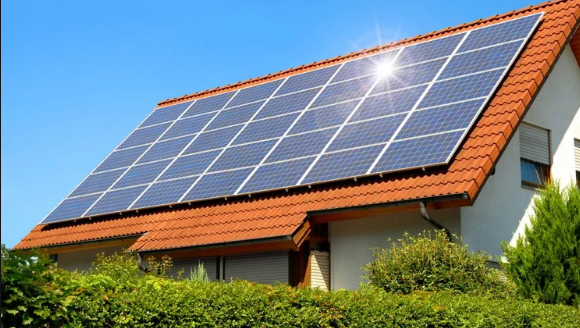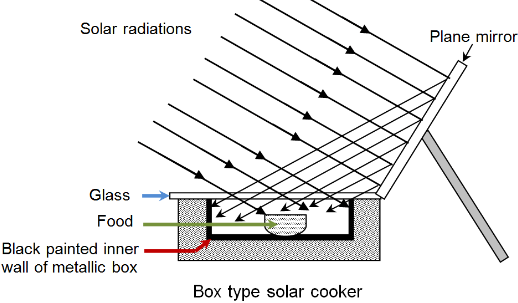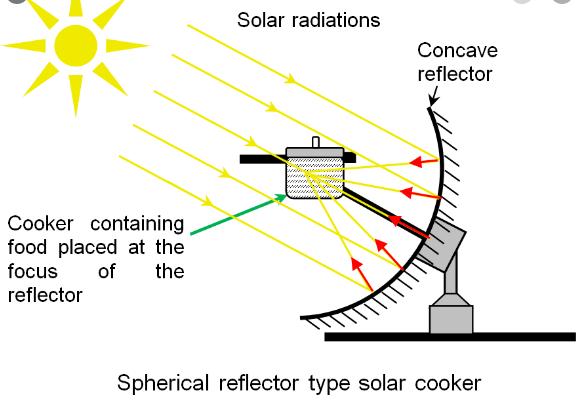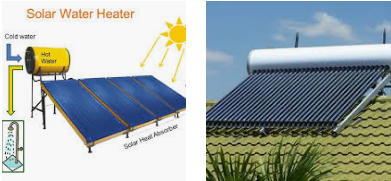 |
SOLAR ENERGY
The energy obtained from the sun is called solar energy.
The sun is one of the major sources of renewable energy. Solar energy consists of heat and light.
The nuclear fusion reactions taking place inside the sun keep on liberating enormous amounts of heat and light energy. This heat and light energy is radiated by the sun in all directions in the form of solar energy.
Since the sun is very, very far away, only a small fraction of the solar energy radiated by the sun reaches the outer layer of the earth's atmosphere.
Uses :
(i) The solar energy which reaches the earth is absorbed by land and water-bodies (like rivers, lakes and oceans), and plants.
(ii) The solar energy trapped by land and water-bodies causes many phenomena in nature like winds, storms, rain, snowfall, and sea-waves, etc.
(iii) Plants utilize solar energy to prepare food by the process of photosynthesis.
(iv) Scientists have made a number of devices which help in utilizing the solar energy directly in our everyday life.
The devices which work by using solar energy (or sun's energy) are : Solar cooker, Solar water heater, and Solar cell.
SOLAR CONSTANT
Energy received by earth from the sun is about 1.4 kilojoules per second per square metre, and this quantity is called the solar constant.
SOLAR HEATING DEVICES :
A device which gets heated by using sun's heat energy is called a solar heating device. A solar cooker and solar water heater are solar heating devices. Though a large amount of sun's heat energy falls on the earth but it is very much diffused (spread over a large area) and not concentrated. So, in order to use .sun's heat energy for heating purposes, we have to collect and concentrate it. All the solar heating devices are designed in such a way that they help in collecting as much sun's heat rays as possible. This is done by using a black painted surface, a glass sheet cover, and in some cases also a plane mirror reflector. A black painted surface is used because black surface absorbs more heat rays of the sun than a white surface. A glass sheet is used as a cover in solar heating devices because a glass sheet traps more and more of sun's heat rays by producing greenhouse effect. A plane mirror reflector is used (in solar cooker) to increase the area over which solar energy is collected so that more heat rays of the sun may enter the solar cooker box.
BOX TYPE SOLAR COOKER :
The solar cooker is a device which is used to cook food by utilizing the heat energy radiated by the sun. A solar cooker consists of an insulated metal box or wooden box which is painted all black from inside.
There is a thick glass sheet cover over the box and a plane mirror reflector is also attached to the box.
The food to be cooked is put in metal containers which are painted black from outside. These metal containers are then placed inside the solar cooker box and covered with the glass sheet.
HOW THE SOLAR COOKER WORKS :
In order to cook food, the solar cooker is kept in sunshine, outside the house. The reflector of solar cooker is adjusted in such a way that it faces the sun. When the sun's rays fall on the reflector, the reflector sends them to the top of solar cooker box in the form of a strong beam of sunlight. The sun's heat rays pass through the glass sheet cover and get absorbed by the black inside surface of the cooker box.
Once the sun's heat rays enter the cooker box, then the glass sheet cover does not allow them to go back. In this way, more and more heat rays of the sun get trapped in the box due to which the temperature in the solar cooker box rises to about 100°C to 140°C in two to three hours.
This heat cooks the food materials kept in the black containers.
LIMITATION OF BOX TYPE SOLAR COOKER :
The box-type solar cooker can be used to cook only those food materials which require slow heating. The box-type solar cooker cannot be used to cook those foods where strong heating is required. For example, the box-type solar cooker cannot be used for baking and for frying because they require stronger heating .
SPHERICAL REFLECTOR-TYPE SOLAR COOKER :
In order to achieve higher temperatures required for baking and frying, spherical reflector-type solar cooker (having a concave reflector) is used. When a concave mirror reflector is attached to a solar cooker, it converges a large amount of sun's heat rays at its focus due to which a high temperature is produced in the focus area (which is suitable for baking and frying). Thus, a concave mirror reflector is best suited for use in a solar cooker.
ADVANTAGES OF A SOLAR COOKER :
(i) The use of solar cooker for cooking food saves precious fuels like coal, kerosene and LPG.
(ii) The use of solar cooker does not produce smoke due to which it does not pollute air.
(iII) When food is cooked in solar cooker, its nutrients do not get destroyed. This is because in a solar cooker, food is cooked at a comparatively lower temperature.
(iv) In a solar cooker, up to four food items can be cooked at the same time.
LIMITATIONS (OR DISADVANTAGES) OF A SOLAR COOKER:
(i) The solar cooker cannot be used to cook food during night time (because sunshine is not available at that time).
(i) If the day-sky is covered with clouds, even then solar cooker cannot be used to cook food.
(iii) The direction of reflector of solar cooker has to be changed from time to time to keep it facing the sun.
(iv) The box-type solar cooker cannot be used for baking or for frying.
SOLAR WATER HEATER :
If a coil of copper tube painted black from outside is placed in a box similar to that of solar cooker, it will work as a solar water heater. This is because when water is passed through the copper coil, it will absorb sun's heat rays and become hot. Solar water heaters are used to supply hot water in big buildings like hotels and hospitals. A solar water heater cannot be used to get hot water during the night or on a cloudy day.
SOLAR CELLS :
Solar cells use the energy in sunlight to produce electricity. Thus, solar cell is a device which converts solar energy directly into electricity.
A solar cell is usually made from silicon. A simple solar cell consists of sandwich of a 'silicon-boron layer' and a 'silicon-arsenic layer'. The amount of boron and arsenic present in the two silicon layers is very small. A small piece of wire is soldered into the top of upper layer of cell and another piece of wire is soldered at the bottom of the lower layer.
The solar cell is covered with a glass cover or a transparent plastic cover for protection.
When sunlight falls on the surface of solar cell, it makes the loosely held electrons in the silicon atoms move due to which a current begins to flow in the wires connected to the top and bottom of the solar cell. The strength of current produced depends on the brightness of the light and the efficiency of solar cell.
A potential difference (or voltage) of about 0.5 V is generated between the top and bottom surface of a solar cell.
SOLAR CELL PANEL :
A single solar cell can produce only a small amount of electricity, In those cases where more electrical power is needed, a large number of solar cells are joined together in series. This group of solar cells is called a 'solar cell panel'.
Thus, a solar cell panel consists of a large number of solar cells joined together in a definite pattern. A solar cell panel can provide much more electric power than a single solar cell.
The various solar cells in a solar cell panel are joined together by using connecting wires made of silver metal. This is because silver is the best conductor of electricity. The use of silver for connecting solar cells makes it more expensive but it increases the efficiency of solar cell panel.
 |
At many places, the solar cell panels are mounted on specially designed inclined roofs so that more solar energy (or sunlight) is incident on them. |
ADVANTAGES OF SOLAR CELLS :
The main advantages of solar cells are that they have no moving parts, they require almost no maintenance, and work quite satisfactorily without the use of any light focussing device.
Another advantage of solar, cells is that they can be set up in remote, inaccessible and very sparsely inhabited areas where the laying of usual power transmission lines is difficult and expensive.
DISADVANTAGE OF SOLAR CELLS :
The main disadvantage of solar cells is that they are very expensive. This is due to the following reasons :
(i) the special grade silicon needed for making solar cells is expensive,
(ii) silver wire used to interconnect solar cells for making solar cell panels is expensive.
(iii) the entire process of making solar cells is still very expensive. So, the extensive use of solar cells for generating electric power is limited due to their high cost.
(iv) Another disadvantage of solar cells is their low efficiency. They can convert only about 25 per cent of the light energy falling on them into electricity.
USES OF SOLAR CELLS
1. Solar cells are used for providing electricity in artificial satellites and space probes.
2. Solar cells are used for providing electricity to remote, inaccessible and isolated places where normal electricity transmission lines do not exist.
3. Solar cells are used for the transmission of radio and television programmes in remote areas.
4. Solar cells are used for providing electricity to 'light houses' situated in the sea and to off-shore oil drilling rig platforms.
5. Solar cells are used for operating traffic signals, watches, calculators and toys.






No comments:
Post a Comment